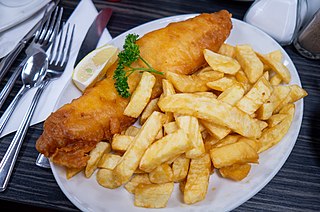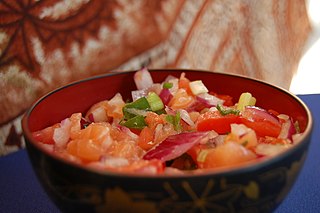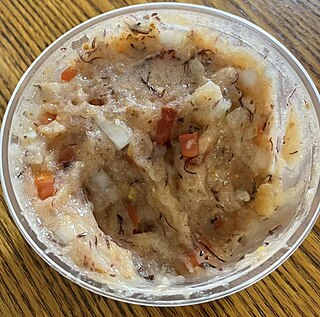
Buddhist cuisine is an Asian cuisine that is followed by monks and many believers from areas historically influenced by Mahayana Buddhism. It is vegetarian or vegan, and it is based on the Dharmic concept of ahimsa (non-violence). Vegetarianism is common in other Dharmic faiths such as Hinduism, Jainism and Sikhism, as well as East Asian religions like Taoism. While monks, nuns and a minority of believers are vegetarian year-round, many believers follow the Buddhist vegetarian diet for celebrations.

Japanese cuisine encompasses the regional and traditional foods of Japan, which have developed through centuries of political, economic, and social changes. The traditional cuisine of Japan is based on rice with miso soup and other dishes with an emphasis on seasonal ingredients. Side dishes often consist of fish, pickled vegetables, and vegetables cooked in broth. Common seafood is often grilled, but it is also sometimes served raw as sashimi or as sushi. Seafood and vegetables are also deep-fried in a light batter, as tempura. Apart from rice, a staple includes noodles, such as soba and udon. Japan also has many simmered dishes, such as fish products in broth called oden, or beef in sukiyaki and nikujaga.

Thai cuisine is the national cuisine of Thailand.

Vietnamese cuisine encompasses the foods and beverages originated from Vietnam. Meals feature a combination of five fundamental tastes : sweet, salty, bitter, sour, and spicy. The distinctive nature of each dish reflects one or more elements, which are also based around a five-pronged philosophy. Vietnamese recipes use ingredients like lemongrass, ginger, mint, Vietnamese mint, long coriander, Saigon cinnamon, bird's eye chili, lime, and Thai basil leaves. Traditional Vietnamese cooking has often been characterised as using fresh ingredients, not using much dairy or oil, having interesting textures, and making use of herbs and vegetables. The cuisine is also low in sugar and is almost always naturally gluten-free, as many of the dishes are rice-based instead of wheat-based, made with rice noodles, papers and flour. Vietnamese cuisine is strongly influenced not only by the cuisines of neighboring China, Cambodia and Laos, but also by French cuisine due to French colonial rule over the region from 1887 to 1954.

Fish and chips is a hot dish consisting of fried fish in batter, served with chips. The dish originated in England, where these two components had been introduced from separate immigrant cultures; it is not known who combined them. Often considered Britain's national dish, fish and chips is a common takeaway food in numerous other countries, particularly English-speaking and Commonwealth nations.

Donburi is a Japanese "rice-bowl dish" consisting of fish, meat, vegetables or other ingredients simmered together and served over rice. Donburi meals are usually served in oversized rice bowls which are also called donburi. If one needs to distinguish, the bowl is called donburi-bachi and the food is called donburi-mono.
Indian cuisine consists of a variety of regional and traditional cuisines native to the Indian subcontinent. Given the diversity in soil, climate, culture, ethnic groups, and occupations, these cuisines vary substantially and use locally available spices, herbs, vegetables, and fruits.

Thali or Bhojanam is a round platter used to serve food in South Asia, Southeast Asia and the Caribbean. Thali is also used to refer to an Indian-style meal made up of a selection of various dishes which are served on a platter. Thali is also used in south Asia for ceremonial purposes.

Toad in the hole is a traditional English dish consisting of sausages in Yorkshire pudding batter, usually served with onion gravy and vegetables. Historically, the dish has also been prepared using other meats, such as rump steak and lamb's kidney. In the 21st century, vegetarian and vegan versions have appeared.

Lomi lomi salmon is a side dish in Hawaiian cuisine containing salted salmon, onions, and tomatoes. Its origin is similar to poisson cru. It also resembles pico de gallo in appearance and to how it is often consumed as an accompaniment to other foods such as poi or kalua pork.

Bibimbap, sometimes romanized as bi bim bap or bi bim bop, is a Korean rice dish.

Buddha Jumps Over the Wall, also known as Buddha's Temptation or Fotiaoqiang, is a variety of shark fin soup in Fujian cuisine. This dish has been regarded as a Chinese delicacy known for its rich taste, and special manner of cooking. The dish's name is an allusion to the dish's ability to entice the vegetarian Buddhist monks from their temples to partake in the meat-based dish, and implies that even the strictly vegetarian Gautama Buddha would try to jump over a wall to sample it. It is high in protein and calcium. It is one of China's state banquet dishes.

Poke is a dish of diced raw fish tossed in sauce and served either as an appetizer or a main course.

The banana leaf is the leaf of the banana plant, which may produce up to 40 leaves in a growing cycle. The leaves have a wide range of applications because they are large, flexible, waterproof and decorative. They are used for cooking, wrapping, and food-serving in a wide range of cuisines in tropical and subtropical areas. They are used for decorative and symbolic purposes in numerous Hindu and Buddhist ceremonies. In traditional homebuilding in tropical areas, roofs and fences are made with dry banana-leaf thatch. Bananas and palm leaves were historically the primary writing surfaces in many nations of South and Southeast Asia.

Lomi or pancit lomi is a Filipino dish made with a variety of thick fresh egg noodles of about a quarter of an inch in diameter, soaked in lye water to give it more texture. Because of its popularity at least in the eastern part of Batangas, there are as many styles of cooking lomi as there are eateries, panciterias or restaurants offering the dish. Variations in recipes and quality are therefore very common.

Kinilaw is a raw seafood dish and preparation method native to the Philippines. It is sometimes also referred to as Philippine ceviche due to its similarity to the Latin American dish ceviche. It is more accurately a cooking process that relies on vinegar and acidic fruit juices to denature the ingredients, rather than a dish, as it can also be used to prepare meat and vegetables. Kinilaw dishes are usually eaten as appetizers before a meal, or as finger food with alcoholic drinks. Kinilaw is also sometimes called kilawin, especially in the northern Philippines, but the term kilawin more commonly applies to a similar lightly grilled meat dish.

Native Hawaiian cuisine refers to the traditional Hawaiian foods that predate contact with Europeans and immigration from East and Southeast Asia. The cuisine consisted of a mix of indigenous plants and animals as well as plants and animals introduced by Polynesian voyagers, who became the Native Hawaiians.
Sweetfin is a Los Angeles–based fast casual restaurant chain that serves poke bowls. Sweetfin was founded in 2013 by Alan Nathan, Brett Nestadt, Seth Cohen and Executive Chef Dakota Weiss, with their first store opening in Santa Monica in April 2015. As of 2018 Sweetfin has nine locations in the California region: eight in Los Angeles and one in San Diego. Sweetfin is regarded as having started the trend of poke specific restaurants outside of Hawaii.

Lomi ʻōʻio is a raw fish dish in traditional Hawaiian cuisine using ʻōʻio (bonefish). This dish is an heirloom recipe fairly unchanged since pre-contact Hawaii, and is a precursor or progenitor to the more well-known but en vogue poke seen today.


















